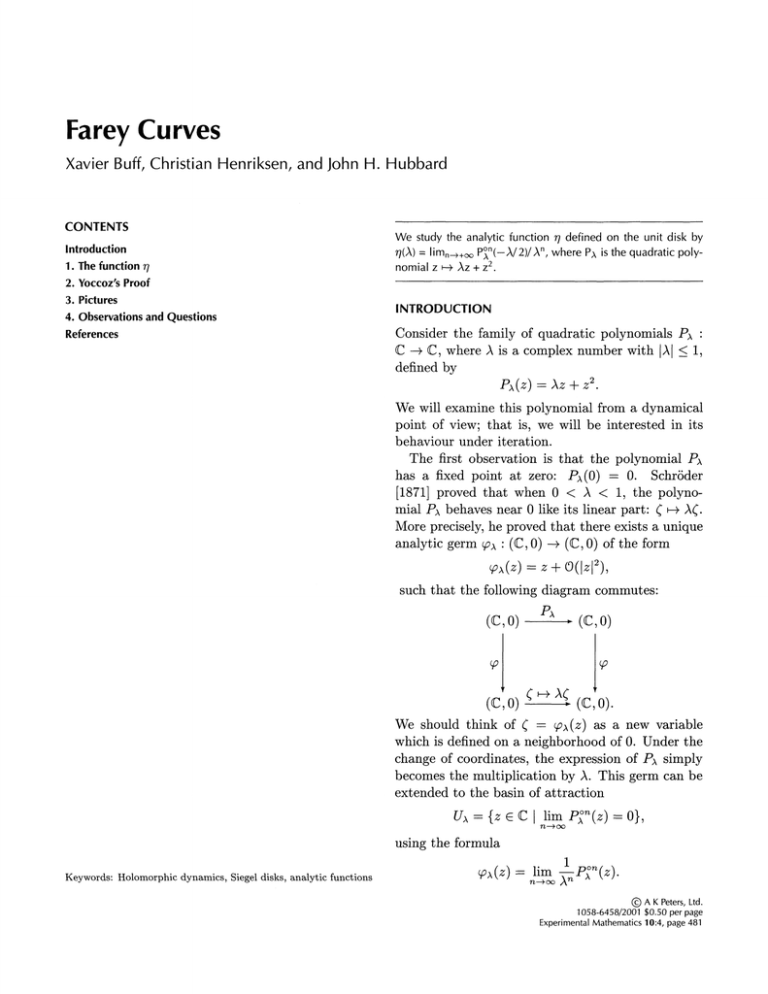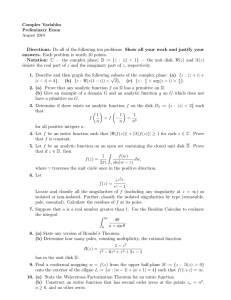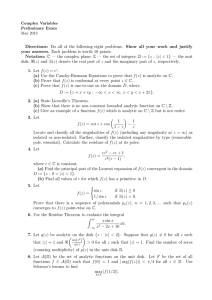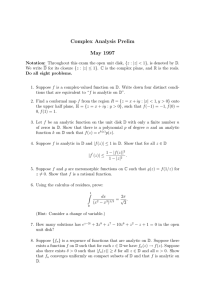Farey Curves Xavier Buff, Christian Henriksen, and John H. Hubbard
advertisement

Farey Curves
Xavier Buff, Christian Henriksen, and John H. Hubbard
CONTENTS
We study the analytic function rj defined on the unit disk by
n
n
v{\) = |jm n ^ + o o P° (-A/2)/A , where PA is the quadratic poly2
nomial z h->> Az + z .
Introduction
1. The function rj
2. Yoccoz's Proof
^nr",
Hn ,
INTRODUCTION
4. Observations and Questions
References
Consider the family of quadratic polynomials PA :
C —> C, where A is a complex number with |A| < 1,
defined by
Px(z) = Xz + z2.
We will examine this polynomial from a dynamical
point of view; that is, we will be interested in its
behaviour under iteration.
The first observation is that the polynomial Px
has a fixed point at zero: P\(0) = 0. Schroder
[1871] proved that when 0 < A < 1, the polynomial P\ behaves near 0 like its linear part: £ i-> A£.
More precisely, he proved that there exists a unique
analytic germ cpx : (C, 0) —> (C, 0) of the form
<px(z) = z + O(\z\2),
such that the following diagram commutes:
(C,o)—^—(c,o)
(Co)i^l(co).
We should think of £ = ip\(z) as a new variable
which is defined on a neighborhood of 0. Under the
change of coordinates, the expression of P\ simply
becomes the multiplication by A. This germ can be
extended to the basin of attraction
Ux = {z G C | lim P°xn(z) = 0},
n—>-oo
using the formula
Keywords: Holomorphic dynamics, Siegel disks, analytic functions
r^A^y
n_^.oo
An
© A K Peters, Ltd.
1058-6458/2001 $0.50 per page
Experimental Mathematics 10:4, page 481
482
Experimental Mathematics, Vol. 10 (2001), No. 4
Fatou [1906] proved that the basin of attraction Ux
always contains the critical point uox — —A/2, and
this result arguably opened the entire field of holomorphic dynamics.
What remains of those results when |A| = 1? If
A = e2i7vp/q is a root of unity, then P is not linearizable. Indeed, if it were linearizable, then Poq would
be equal to the identity. Cremer [1932] proved that
if the Schroder equation
of attraction C/A, hence it is in the filled Julia set
K{PX), which is known to be inside the disk D(0,4).
In particular,
4
|XA(0I < 0-D
Since <p'A(0) = 1, we obtain x'A(0) = r){X). Now
we have seen that Xx is a univalent mapping from
the unit disk to the disk D(0,4). Since XA(0) = 0,
Schwarz's Lemma shows that
(fix(Px(z)) = \<px(z)
has a solution for |A| = 1, then the mapping Vx will
extend to a simply connected region [ / A c C , called
a Siegel disk. Cremer probably believed that this
case could not occur for |A| = 1. The first existence
result for such disks was found by Siegel [1942], in
one of the landmark papers of the twentieth century.
In the late 1980's Yoccoz found an amazingly simpie proof that for almost every A G S 1 , the polynomial Px has a Siegel disk. His proof is based on the
fact that a bounded nonconstant analytic function
77 : D —> C (where D is the open unit disc) has radial
,. ., ,
,
,
i ^i x ^i v -j.
limits almost everywhere, and that the limit supeT I P -i
i
r
r ^
nor of the modulus of 77 vanishes only at a set of
~
., ,
^ ,
,
measure 0 as A tends Lto the boundary.
1. THE FUNCTION 7/
Let A be in D, and let
be the linearizing map for P\(z) = Xz + z2 defined in
the basin U\. The critical point u\ — —A/2 belongs
to this basin, so we can define
ty(A) = VA(^)=Um-^Pr(-A/2).
^(A)! = | x ^(0)| < 4.
T og e e t h a t
^i ga n a l y t i c 5
(1-2)
notice that
p°n( \/2)
^n
is a rational map of A, analytic on D*. It is not
difficult to see that the convergence is uniform on
compact subsets of D*. Hence, 77 is analytic in D*.
Since by equation (1-2) it is bounded by 4, the removability theorem shows that it is analytic in all D.
•
.
_
^
.
.
.
_
,
.
ri
r
omce 77 : D -» (L is a bounded analytic function
.
'
. . ._ . n . , , . - , , . .
that does not vanish identically, it has radial limits
.
.
_.
'
„, _.
almost everywhere, and the set of a G o such that
limsup|77(A)| = 0
x
^
^
I - | + \i
v
jfS^ ^
^^
M< "
f | ^ 7 ^x^^^s^L
^ ^ '
'
^
\+¥
^" ^ ^ k ,
"
// ^ ^ ^
7
(Z\ '
^ ^ ^
^^ ^ ^ f l
Proposition 1.1. The function TJ(X) is analytic and
bounded in the unit disk.
@m^^
^^^^r
Proof. The critical values of cpx are the points r](X)/\n,
for n > 0. Hence, the disk O(0, |r/(A)|) does not
contain any critical value of <px. Since it is simply
connected, there exists an inverse branch
^ ^ ^ ^ ^ ^ ^ ^ ^ i\y(\) ^ ^~^^^^C^
^ ^ ^] / ) / ) \ \
^ / " ^ \ ^\^^y
r
\lihp/f~~~\/ I i '^
^-(^^^w
W / L / ) ' /j )\
\ ^\ x A x l ^ ^ ^ ^
^ = ^ : D(0, h(A)|) -> ^
defined on D(0, |r?(A)|) and such that VA(0) = 0.
Then, the function Xx(0 = i>\(€vW) i sa n injective analytic function on the unit disk, which vanishes at 0. Moreover, X\(0 belongs to the basin
^^ ~ ^ ^ " ^ ( 2 )
<?ill
/ ^\^
- - ^^li^ll
^ ^ ^ P ^ ^ ^ ^
^^^^^^0^
1 _ 1.
1
x.
I ~ 3 ~ 32
.
!—L_
FIGURE 1. The image of the circle |A| = .9999 by the
map »j(A), where 7(4) = ry(.9999e27rit).
Buff, Henriksen, and Hubbard: Farey Curves
483
is of measure 0. This function rj(X) : D —> C is quite
surprising. We will see that if rj(X) does not tend to
0 when A -> \i G S 1 , then the polynomial P(z) =
jiz + z2 has a Siegel disk. In particular, the limit
must be 0 when \x G S1 is a root of unity. On the
other hand, the radial limit must be positive on a set
of measure 1. In order to understand the boundary
behaviour of the function 77, we have drawn the curve
SJ.\
( c\c\c\c\ 2irit\
T^i
Theorem 2.2. Set A = e2lxie. The polynomial Px is
linearizable if and only if 6 G R \ Q and
oo ,
V^
< oo,
(2-1)
n=i ^ n
where pn/qn is the n-th convergent of the continued
fraction of 9.
'y(t) = 77(.9999ej7r**) on Figure 1.
J
v
J
„ , n ,
f
called a Brjuno number.
Even though the Brjuno numbers have full measure on the circle, the complement is a dense un-
2. YOCCOZ'S PROOF
TL
_ . rpi
. .
, o r- o\
Theorem 2 . 1 . There exists a set S C S
£
i
of measure 1
L ±i. J. -£ \
a J.-L
J ±- 7
• i r» / \
such that it A G o, the quadratic polynomial P\(z) —
x , 2 • I• j.i
• M. \
A /n
Az + 2T Z5 linearizable in a neighborhood ofi).
Proof. We have seen (equation (1-1)) that the family {XA}AGP i s uniformly bounded by 4. By Montel's theorem, the family {XA}A<ED ls normal. So
any sequence xxn w^ith An -> // G 5 1 has a con, i
j xi. v -i. • -j.i -J
vergent subsequence, and the limit X is either id«ntically 0 or miective on the unit disk. Notice that
,> x D
/ \ u
-r,i r -4.r ..
X\{*z) = P\°
X\(z)' Hence, if the limit function \
. . . ,.
.. x . n
/ \
r>
/ \ •
-l
is mjective, it satisfies
x(/^0 = P» ° x W . i-e., X
linearizes PM near 0.
An angle 0 satisfying the condition (2-1) above is
countable set (fat in the sense of Baire). Yoccoz's
r
_
,
.r n -
^ .
i
proot shows that it v is not a Briuno number, then
_
^ ,
. ^
,
/AN
o . fl m l .
r?(A) tends t o 0 when A G B tends t o e 2 ^ . This exi .
i
• ii
T IT.
r I r
plains the weird boundary behaviour or the function
ry(A) which appears on Figure 1.
3. PICTURES
.
,.
Figure 2 shows the images of the circles A = .5,
^
=
=
=
= gg
=
' '
' ' '
/AN
.9999 under the map 7?(A).
w
. • ,-r ^
^
•.
j
We must justify how those pictures are drawn,
Recall that
rj(X) - lim — P A o n f—V
The function
i2(/i) = lim sup |r/(A) |
O n t h eo t h e r h a n d
»
w ek n o w t h a t
•K*)-^(-i)-^M-|)).
on the unit circle vanishes only on a set of measure 0.
Since XA(0) = 7/(^)5 if M = e2wi0 1Sm the complement
S of this set, then a sequence An converging to \i can
be chosen such that the sequence Xxn converges to
X, and
, ,/^M u.
, ^xi n , x ^
\X (0)| = I l i r n , ^ X , n (0)| = R(») > 0,
so that the limit is not constant.
•
The proof above gives little insight into the nature
of angles <9 for which the polynomial
P(z)
— e27riez + z2
is or is not linearizable. We will now give a result
which should bring out the arithmetic nature of such
angles. The first such result was obtained by Siegel
in 1942. Brjuno [1971] and Yoccoz [1995] have since
completely solved the problem.
\ Z / A \
\ z/ /
Hence, we just need to control how close ipx is to
the identity near 0. This can be done using classical
distortion estimates for univalent functions in the
unit disk.
Lemma 3.1. The map (D\ is univalent on the diskTbn
centered
at Q Qf
mdms
R — inf{|A|/2,1 — |A|}.
Proof
- lt i s n o t difficult to show that PA(Dfl) C BR
for all i? < 1 - |A|. This implies that BR C UXj
and so (px is analytic on D^. The polynomial Px is
univalent on t h e half-plane Re(z/X)
> — \ and in
particular it is univalent on D# for R < |A|/2. So,
letting R — inf{|A|/2, 1—|A|}, every iterate Pxn for
n > 0 is univalent on D^. Finally, the linearizing
map <px is locally univalent near the origin and the
functional equation <pxoPx — X-(px yields the desired
univalence of <px.
•
484
Experimental Mathematics, Vol. 10 (2001), No. 4
(-1/3+1/3)
(1/3+1/3)
(-1/3+1/3)
(1/3+1/3)
(-1/3+1/3)
(1/3+1/3)
o Q fj
(-1/3-1/3)
(-1/3+1/3)
^ ^ ^ ^ - ^ ^ ^
(-1/3-1/3)
^ ^ ^ S l ^ /
(V3-1/3)
H /3-i/3)
(1/3+1/3)
(-1/3+1/3)
(1/3.i/3)
( _ 1/3 _ j/3)
,-<«•-"
^
-
,
(1/3-1/3)
(_i/3-i/3)
* \ ^
d/3+1/3)
(-1/3+1/3)
r'
(1/3_j/3)
( _ 1/3 _ j/3)
0/3-1/3)
^ , ^ | ^ ^ ^ ^ ^ _
^
^
^
^
^
^
(1/3+1/3)
(1/3-1/3)
FIGURE 2. Images of the circles |A| = .5, |A| = .75, |A| = .9, |A| = .99, |A| = .999, and |A| = .9999 under ry(A).
Lemma 3.2. / / \z\ < R/2, where R is the lesser of
|A|/2 and 1 — |A|, then
The lemma gives rise to a method of computing arbitrarily good approximations of 77(A). Since
M*)-*|<-|M a .
Pn-A/2)-^0
JrC
Proof. First notice that the function
a
/W-^(«»),
is univalent inD, /(0) = 0 and f'(0) = 1. The result
is then a consequence of the distortion theorem applied to / . Indeed, it is possible to prove that when
\w\<r< 1,
\f(w)-w\<j^-\w\2.
(i-H2
For more details, see [Duren 1983]. In particular, if
\w\ < 1/2, then \f(w) — w\ < 6\w\2, and replacing w
,
IT)
.
by z/R, we get
I
/x
,
6. 2
R
^ = ^(^(-5))w e c a nc h o o s e n
= n ( A ) s u c h t h a t l P A° n (-A/2)| <
mf {JR/2, Re/6}. If we set
Pon(—X/2)
VW = Xn
then
1 6 o
2
| P r (
A / 2 ) | 2
"^
" p^l
~
" 6|?)(A)I'
.
.,
, .
Hence 7? approximates r\ with a relative error that
' f;
'
TT
is bounded by 6. Using this we have drawn the approximat ions of r]({ \ A| = p}), for increasing p shown
in Figure 2, with a precision e — 10~3.
|r/(A)
A)l
Buff, Henriksen, and Hubbard: Farey Curves
4. OBSERVATIONS AND QUESTIONS
^r ,
, ,, , ,, r
i
We have proved that the function r\ has a nonvanishing radial limit almost everywhere. Besides, if 9
,
.
,
,
,, ,
is not a oBriuno number, we have seen that
lim^ rj(X) = 0.
In fact, Yoccoz [1995] obtained a much stronger result. He proved that the radial limit
/
o•
x
limr? (re2l7r6;)
r->i v
exists everywhere and is equal to the conformal radius of the Siegel disk of Pe^e. In particular, the
radial limit is positive when 0 is a Brjuno number;
it is equal to 0 when 0 = p/q is rational.
Moreover, in Figure 2, we observe that as p increases, "bubbles" are formed and seem to reach towards the origin. It is very natural to try to see
what those bubbles correspond to. We have seen
that if 0 G Q is rational, then
lim rj(X) = 0.
x e2ind
-^
One problem is to understand what relation there is
between the bubbles and rational angles 6.
A bubble is formed each time a curve of the family 77({| AI = p}), 0 < p < 1, passes through a critical
point of 77. Hence, understanding the relation between the bubbles and the rational angles amounts
to understanding the relation of the critical points
of 77 and those rational angles. To study the critical
points of 77, we must study 77'. The following limit
is uniform on every compact subset of D:
485
• The only rational number of depth 1 is 1/2, and
there is an edge between 1/2 and each number of
'
^T
.'
,
.
_,
• Now if p/q is a rational number of depth n, we
_
/
,
/ , ,
.
let pi/qi and P2/92 be the two rational numbers
of depth less than n closest to p/q, such that
P1/Q1 < P/Q < Pi/qi- Then,
— — - and — — q
i
+
q
q
2
+
q
fl
So by choosing a large enough n for each A, we can
estimate 77'. In Figure 3 we color pixels black if the
corresponding A satisfies Re(77'(A)2) > 0 and otherwise we color the pixels white. A point A is a
critical point of 77 of degree n if and only if 2n regions of black and white meet in a sufficiently small
neighborhood of A. That is, the critical points are
the corner points in the figure; all of them appear
to be simple critical points.
The position of the critical points seems to reflect
the structure of the Farey tree (see Figure 4). The
Farey tree is defined by induction:
• The rational numbers of depth 0 are 0/1 and 1/1.
are rational numbers of depth n + 1 and there is
an
edge between p/q and each of them,
T h e F a r e y t r e e c o n t a i n s a l l r a t i O nal numbers in [0,1].
I t ig m u s t r a t e d i n F i g u r e 4 u p t o d e p t h 14# A r a t i o .
n a l n u m b e r p/q o f d e p t h n i s d r a w n i n t h e d i s k w i t h
n
a r g u m e n t 2-xp/q and radius r^ . We chose r = .65
t o g h o w t h e s i m i l a r i t y between the position of the
critical pointg a n d t h e s t r u c t u r e of t h e F a r e y tree.
F i g u r e 4 s u g g e s t s t h e following conjecture: for
e a c h r a t i o n a l n u m b e r p/q, there is a gradient curve
°f I7?! joining e27vip/q to a critical point of 77; these
segments define a bijective correspondence between
Q / Z and the critical points of 77.
DCFFRF\irF<;
[ Br J uno
1971
ferential
p—
tf-'
/*
1 A - D - Brjuno, "Analytic form of dif<l uations > r'> T™dy Moskov. Mat Obsc.
,,o t
—
-<t..
^ "°
**''*'**
%r
**>.
^
e
/
^ ^
IB
^ ^
^ ^
\
*
\
^^^^^B
^^^^^^B
y
\
^ ^
11
**ot»
#m
^^^^^^
^ ^ ^ ^
^^^^BV
^^^^^V
^^^^Hf
^ ^ ^
J'
?
<p '
.9*"'"*'
1_i
FIGURE 3. The critical points of rj are the corner points.
486
Experimental Mathematics, Vol. 10 (2001), No. 4
3/7/y
^
^k
o ^ i ^ ^
/ *
1/2
\
0/1=l/l
FIGURE 4. The critical points of 77 and the Farey tree up to depth 14.
25 (1971), 119-262. In Russian; translated in Trans.
Mosc. Math. Soc. 25 (1971).
[Fatou 1906] P. Fatou, "Sur les solutions uniformes de
certaines equations fonctionnelles", C. R. Acad. Sci.
Paris 143 (1906), 546-548.
[Cremer 1932] H. Cremer, "Uber die Schrodersche
Funktionalgleichung und das Schwartsche Eckenabbildungsproblem", Ber. Verh. Sachs. Akad. Wiss.
Leipzig, Math.-Phys. Kl. 84 (1932).
[Schroder 1871] E. Schroder, "Ueber iterirte Function e n » 5 Math. Ann. 3 (1871), 296-322. See http://
gdz.sub.uni-goettingen.de/en/index.html.
ri^
IOQQI o T T^
TT • 1 * * *n
A
[Duren 1983J P. L. Duren, Univalent functions, Grundlehren der Math. Wissenschaften 259, Springer, New
York, 1983.
[Siegel 1942] C. L. Siegel, "Iteration of analytic functions
"» Annals of Math. 43 (1942), 607-612.
v
'
[Yoccoz 1995] J. C. Yoccoz, Petits diviseurs en dimension
1, Asterisque 231, Soc. math. France, 1995.
Xavier Buff, Universite Paul Sabatier, Laboratoire Emile Picard, 118, route de Narbonne, 31062 Toulouse, France
(buff@picard.ups-tlse.fr)
Christian Henriksen, Technical University of Denmark, Department of Mathematics, 2800 Lyngby, Denmark
(chris@mat.dtu.dk)
John H. Hubbard, Cornell University, Malott Hall, Ithaca, NY 14853, United States (jhh8@cornell.edu) and
Universite de Provence, Centre de Mathematiques et d'Informatique, 39 Rue Joliot-Curie, 13453 Marseille Cedex
13, France
Received March 16, 1998; accepted in revised form July 15, 2000








